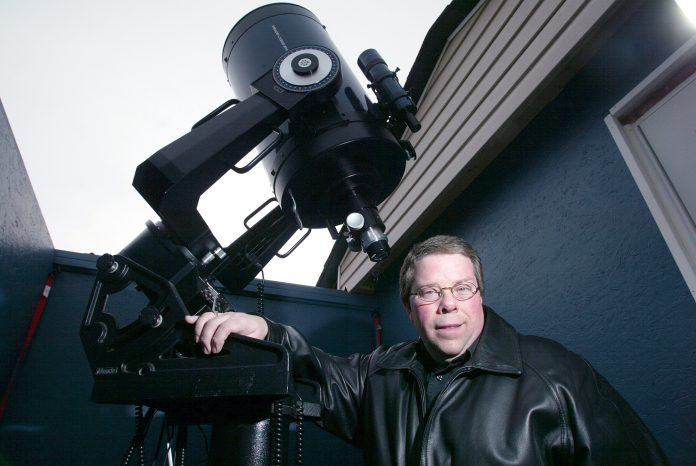Science
Interstellar Visitor 3I Atlas Sparks Curiosity Among Scientists

Scientists are closely monitoring an interstellar object named 3I Atlas, which has begun to exhibit unusual behaviors that defy typical comet characteristics. Discovered on its approach from the direction linked to the famous WOW signal, this object has ignited curiosity and debate among astronomers and the public alike. Its trajectory suggests it is arriving from the Milky Way’s Sagittarius constellation, a path that aligns closely with the 1977 radio signal detected by SETI researchers.
Unusual Characteristics Challenge Conventional Understanding
Initially classified as a comet, 3I Atlas has raised eyebrows due to its peculiar behavior. Gary Boyle, an astronomy educator and former president of the Royal Astronomical Society of Canada, noted that the object displayed an anti-tail, a phenomenon rarely seen in comets, where the tail points towards the sun instead of away. “That’s another question mark on what this thing really is,” he stated. For several months, Atlas showcased only this anti-tail, with no conventional tail present.
As the object approached the sun, several anomalies were detected. The color of 3I Atlas changed multiple times, and astronomers observed seven jets emanating from it. Boyle suggested these jets could potentially act like thrusters on a spacecraft, raising questions about the object’s nature. “It has seven jets coming out of it. Could these jets be thrusters like we have in our spacecraft?” he asked, highlighting the mystery surrounding Atlas.
Perhaps the most perplexing characteristic is the object’s non-gravitational acceleration. Instead of slowing down after its closest approach to the sun, 3I Atlas is accelerating. While natural comets may experience minor deviations due to gas jets, the scale of Atlas’ behavior has drawn significant attention.
Upcoming Close Encounter and Image Release Delays
The closest approach of 3I Atlas to Earth is anticipated around December 19, 2023, when it will be approximately 400 million kilometers away. Although this distance poses no threat, it raises further questions about the object’s trajectory through our solar system. “It has already passed Venus, Mars, and Jupiter within tens of millions of kilometers,” Boyle explained, likening its path to that of previous spacecraft.
Notably, the Mars Reconnaissance Orbiter reportedly captured detailed images of the object on October 2 and 3, 2023, but the data has not been released due to a recent government shutdown in the United States. “The scientific community is waiting to see those clear pictures,” Boyle said, emphasizing the significance of the imagery for understanding Atlas. The delay has led to speculation regarding the content of the images, with some suggesting that NASA may have discovered something noteworthy.
Boyle’s comments reflect a broader conversation within the scientific community, particularly regarding the contrasting views on the nature of 3I Atlas. Avi Loeb, a Harvard astrophysicist, has vocally advocated for the release of the images, proposing the possibility that Atlas could be an artificial probe. “Even Avi Loeb from Harvard is saying it could be an interstellar vehicle or a probe,” Boyle confirmed. In contrast, British physicist Brian Cox has dismissed these theories as distractions from empirical data, sparking a public debate.
This discourse highlights a deeper question about humanity’s understanding of interstellar objects. Boyle expressed a willingness to entertain the possibility of alien technology, stating, “Alien technology could be underlying,” a notion he approached with caution. He noted that advanced technology might operate in dimensions beyond human perception, referencing Carl Sagan‘s concept of Flatland to illustrate the limitations of human understanding.
Public Reaction and Future Implications
The interest in 3I Atlas has already sparked curiosity among the public, particularly in regions like Saskatchewan, where dark skies provide excellent conditions for amateur astronomy. Following recent displays of the Northern Lights, residents have been eager to learn more about this interstellar visitor. Boyle remarked that heightened interest in astronomical phenomena could inspire greater engagement in science.
As the scientific community awaits the release of the images from NASA, Boyle emphasized the potential for 3I Atlas to reshape our understanding of the universe. “This might be real,” he said, suggesting that the object could leave a lasting legacy in both scientific data and public imagination. With approximately 400 billion stars in the Milky Way, he noted, “It’s really hard to argue we are the only ones.”
As the situation develops, all eyes remain on NASA for the forthcoming images that may resolve or deepen the mysteries surrounding 3I Atlas. Whether the answers lie in confirming known physics or opening the door to new questions, the conversation sparked by this interstellar visitor is sure to continue.
-

 Science3 months ago
Science3 months agoToyoake City Proposes Daily Two-Hour Smartphone Use Limit
-

 Top Stories3 months ago
Top Stories3 months agoPedestrian Fatally Injured in Esquimalt Collision on August 14
-

 Health3 months ago
Health3 months agoB.C. Review Reveals Urgent Need for Rare-Disease Drug Reforms
-

 Technology3 months ago
Technology3 months agoDark Adventure Game “Bye Sweet Carole” Set for October Release
-

 World3 months ago
World3 months agoJimmy Lai’s Defense Challenges Charges Under National Security Law
-

 Lifestyle3 months ago
Lifestyle3 months agoVictoria’s Pop-Up Shop Shines Light on B.C.’s Wolf Cull
-

 Technology3 months ago
Technology3 months agoKonami Revives Iconic Metal Gear Solid Delta Ahead of Release
-

 Technology3 months ago
Technology3 months agoApple Expands Self-Service Repair Program to Canada
-

 Technology3 months ago
Technology3 months agoSnapmaker U1 Color 3D Printer Redefines Speed and Sustainability
-

 Technology3 months ago
Technology3 months agoAION Folding Knife: Redefining EDC Design with Premium Materials
-

 Business3 months ago
Business3 months agoGordon Murray Automotive Unveils S1 LM and Le Mans GTR at Monterey
-

 Technology3 months ago
Technology3 months agoSolve Today’s Wordle Challenge: Hints and Answer for August 19









